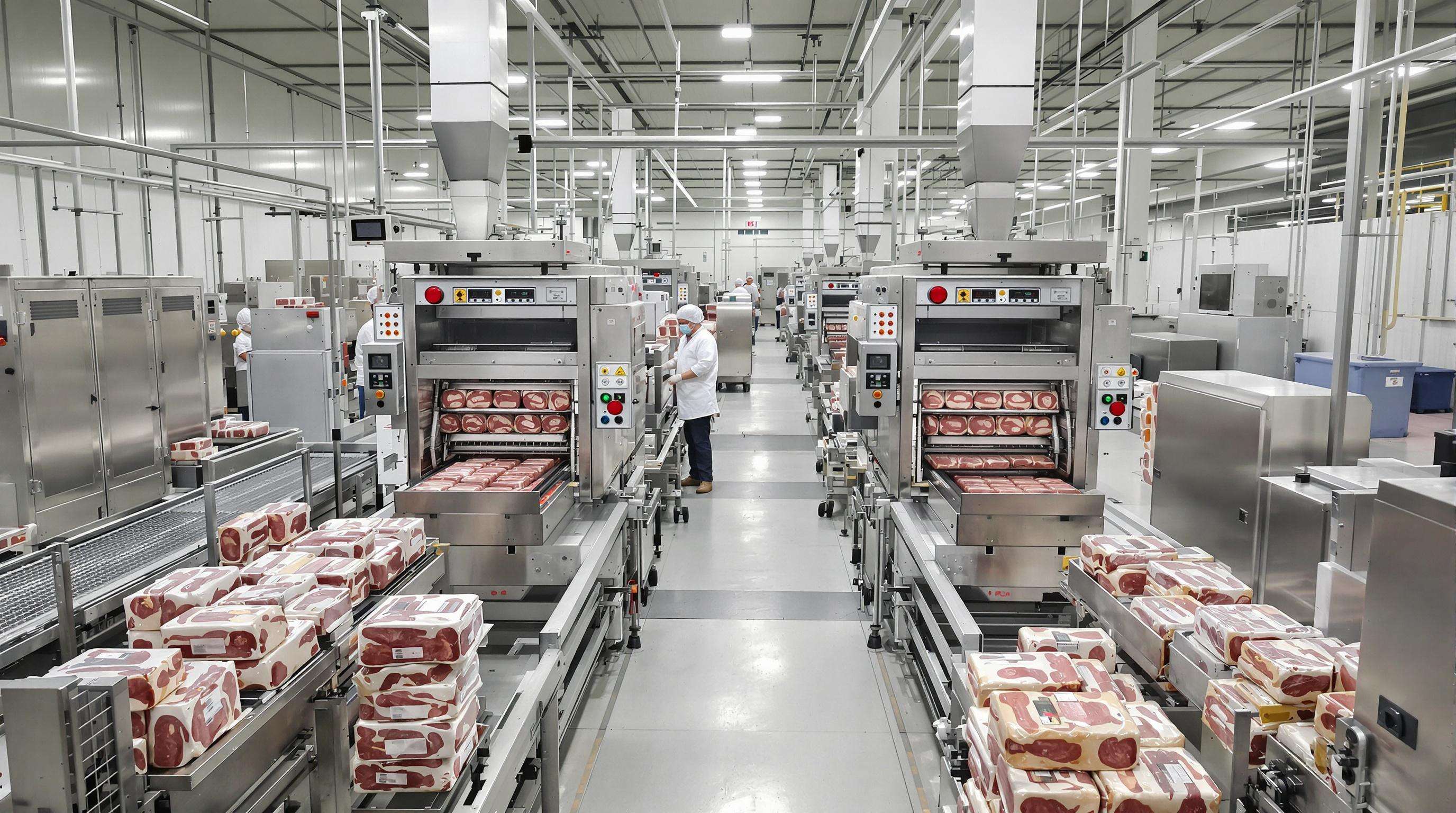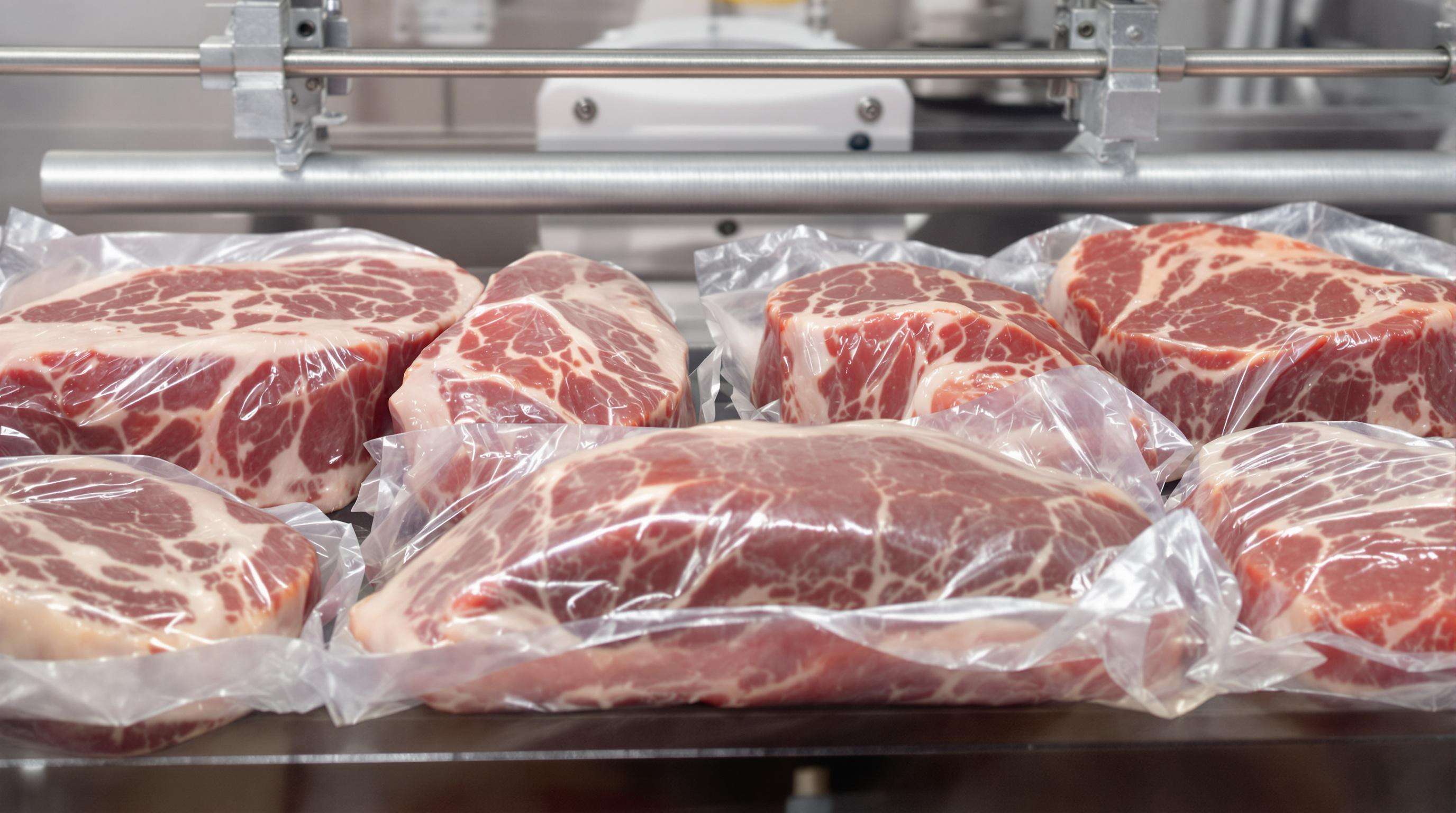ထုတ်လုပ်မှုပမာဏများပြားခြင်းနှင့် စွမ်းဆောင်ရည် ထိရောက်မှု

တူညီသည့် အိမ်သာလောင်းပစ္စည်း ရောင်းချရန် စက်မှု ထုတ်လုပ်မှုနှင့် စက်ရုံ၏ ထုတ်လုပ်နိုင်စွမ်းကိုက်ညီမှု
သင်၏စက်ရုံ၏ ထုတ်လုပ်မှုနှုန်းနှင့်ကိုက်ညီသော အသားထုပ်ပိုးသည့်စက်ကိုရွေးချယ်ခြင်းသည် ထိရောက်မှုနည်းပါးမှုများကို ကာကွယ်ပေးပါသည်။ နေ့စဉ် 8,000–12,000 ယွန်းကိုက်ဖြတ်လုပ်ဆောင်နေသည့် စက်ရုံများအတွက် တစ်မိနစ်လျှင် 100–150 ထုပ်ကို ထုတ်လုပ်နိုင်သည့်စနစ်များ လိုအပ်ပါသည်။ အသားငယ်စက်ရုံများ (<5,000 ယွန်း) အတွက်မူ မော်ကွန်းလိုက် တစိတ်တပိုင်း အလိုအလျောက်ဖြင့် ထုပ်ပိုးသည့်စနစ်များကို အသုံးပြုခြင်းသည် အကျိုးရှိပါသည်။ စက်ပစ္စည်းများကို အကျယ်လွန်းပါက စွမ်းအင်စရိတ်ကို 15–20% ထိတိုးလာစေပြီး အနောက်ကျသော စက်များကို အသုံးပြုပါက အတက်ကြွဆုံးအချိန်များတွင် ထုတ်လုပ်မှုကျပ်တည်းမှုဖြစ်စေပါသည်။
အသားဖြတ်လုပ်ဆောင်သည့်စက်ရုံများအတွက် ထုတ်လုပ်မှုပမာဏသည် စက်ပစ္စည်းရွေးချယ်မှုကို မည်သို့သက်ရောက်မှုရှိသနည်း
နေ့စဉ် ယူနစ် ၂၀,၀၀၀ ကျော်ကိုင်တွယ်ဖြည့်စွက်နေသည့် စက်မှုလုပ်ငန်းများသည် နာရီပိုင်းအလုပ်လုပ်သည့်စက်များနှင့် ထုတ်ကုန်များအကြားတွင် အမြန်ပြောင်းလဲနိုင်သည့်စက်များကို လိုအပ်ပါသည်။ ၂၀၂၅ ခုနှစ်က ထုတ်ဝေသည့် အစီရင်ခံစာတစ်ခုတွင် အကြီးစားစက်မှုလုပ်ငန်းများအကြောင်း စိတ်ဝင်စားဖွယ်အချက်များကို ဖော်ပြခဲ့ပါသည်။ စက်မှုလုပ်ငန်းအဆင့်သင့်တင်ဘို့ ရုံးသုံးပစ္စည်းများကို အများအားဖြင့် ဝယ်ယူခြင်းဖြင့် ကုန်ပစ္စည်းများကို ဈေးနှုန်းချမှတ်နိုင်ခြင်းကို တွေ့ရှိခဲ့ရပြီး ပစ္စည်းကုန်ကျစရိတ်ကို ၂၂ ရာခိုင်နှုန်းခန့် လျော့နည်းစေပါသည်။ ထုတ်လုပ်မှုအထွတ်အထိပ်ကို ထိန်းသိမ်းထားနိုင်ရန်အတွက် တစ်ပြိုင်နက် အလုပ်လုပ်နေသည့် ကွဲပြားသောကွန်ဗဲယာများကို ရှာဖွေတွေ့ရှိရပါမည်။ အင်တာနက်ချိတ်ဆက်မှုလုပ်ဆောင်ချက်များနှင့် တပ်ဆင်ထားသည့်စက်များကိုလည်း စဉ်းစားသင့်ပါသည်။ ထိုကဲ့သို့သော စမတ်စနစ်များက စီမံခန့်ခွဲသူများအား လက်ရှိအခြေအနေများကို စောင့်ကြည့်ရုံသာမက အစိတ်အပိုင်းများ ပျက်စီးမှုဖြစ်မည့်အချိန်ကို ကြိုတင်ခန့်မှန်းနိုင်စေပြီး အနာဂတ်တွင် ငွေကြေးနှင့် အချိန်ကိုခြွေတာနိုင်ပါသည်။
မြင့်မားသောအမြန်နှုန်းဖြင့် အသားထုပ်ပိုးသည့်လုပ်ငန်းများတွင် ရပ်ဆိုင်းမှုကို နိမ့်ပါးစေရန် နည်းလမ်းများ
စက်မှုလုပ်ငန်းအချက်အလက်များအရ ပုံမှန်ထိန်းသိမ်းပြုပင်မှုများကို လုပ်ဆောင်ခြင်းဖြင့် မျှော်လင့်မထားသော စက်ပစ္စည်းရပ်တန့်မှုများကို ၃၅ မှ ၄၀ ရာခိုင်နှုန်းခန့် လျော့နည်းစေနိုင်ပါသည်။ ထိရောက်သော နည်းလမ်းများအနေဖြင့် ဆီတင်စနစ်များကို အသုံးပြုခြင်း၊ စဥ်ဆက်မပြတ် စက်များကို အလုပ်လုပ်နေစဉ်တွင် စစ်ထုတ်ကိရိယာများကို လဲလှယ်နိုင်ရန် ဗကူမ်ကမ္ပညာနှစ်ခုကို ပိုင်ဆိုင်ထားခြင်း၊ နည်းပညာရှင်များသည် စက်ပိုင်းဆိုင်ရာပြဿနာများနှင့် ကွန်ပျူတာ စစ်ထုတ်ကိရိယာများနှစ်မျိုးလုံးတွင် သင်တန်းကောင်းကောင်းတက်ရောက်ထားခြင်းတို့ ပါဝင်ပါသည်။ ရွေ့လျားနေသော အစိတ်အပိုင်းများတွင် တုန်ခါမှုကိရိယာများကို တပ်ဆင်ခြင်းသည် အရာဝတ္ထုများနှင့် ပြဿနာများကို စောစီးစွာ ဖမ်းဆုပ်ရမ်းနိုင်စေပါသည်။ အဘယ်ကြောင့်နည်းဟူမူ ထိုပျက်စီးမှုများသည် စက်ပိုင်းဆိုင်ရာ ရပ်တန့်မှုများ၏ အများစုကို ဖုံးလွှမ်းထားပါသည်။ စက်ရုံမန်နေဂျာများသည် ထိုသေးငယ်သော တုန်ခါမှုများကို ပထမဆုံးသတိပြုမိသောအခါတွင် စက်ပစ္စည်းများ ပြည့်စုံစွာ ပျက်စီးကာ လုပ်ငန်းစဉ်များကို ရပ်တန့်မှုမဖြစ်စေရန် ပြုပင်ပေးနိုင်သည့် အခွင့်အရေးကို ရရှိပါသည်။
စိတ်ကြိုက်ထုတ်လုပ်မှုနှင့် ရှိပြီးသားထုတ်လုပ်မှုတန်းများကို တစ်ပြေးညီချိတ်ဆက်ခြင်း
ခေတ်မီ အသားထုပ်ပိုးမှုစက်များတွင် စိတ်ကြိုက်ထုတ်လုပ်မှု၏ အခန်းကဏ္ဍ
အလိုအလျောက်စနစ်များက အစိတ်အပိုင်းများကို တိကျစွာရယူပေးပြီး ပိတ်ဆို့မှုများကို တည်ငြိမ်စေပြီး အလုပ်သမားများက ထုတ်ကုန်များကို ကိုင်တွယ်ရသည့် အချိန်ကို လျော့နည်းစေပါသည်။ ထို့ကြောင့် အသားစက်ရုံများတွင် လူ့စွမ်းအားအင်အားနည်းပြောမှုကို ဖြေရှင်းရာတွင် အများအားဖြင့် ကူညီပေးပါသည်။ အနောက်ဆုံး ခံစားမှုနည်းပညာများက ထုပ်ပိုးမှုအလေးချိန်များ တရားဝင်ခွင့်ပြုထားသည့် အကန့်အသတ်များအတွင်းတွင် ထုတ်ကုန်များကို လျော့နည်းစွာ စွန့်ပစ်ရန်နှင့် အခွင့်အရေးကို တိုးတက်စေရန် အနောက်ဆုံးခံစားမှုနည်းပညာများက နောက်ပိုင်းတွင် ဖော်ပြထားသည့်အတိုင်း နေရာချမှုများကို ၉၉.၂% အထိ ဖမ်းမိနိုင်ပါသည်။ ထုပ်ပိုးမှုစနစ်များအရ အလိုအလျောက်စနစ်များသည် တစ်မိနစ်လျှင် ယူနစ် ၈၀ မှ ၁၂၀ အထိ ပုံမှန်အားဖြင့် လည်ပတ်ပါသည်။ ထိုကဲ့သို့ အမြန်နှုန်းမြှင့်တင်မှုမှာ လုပ်ငန်းစဉ်များကို ပိုမိုချောမွေ့စွာ လည်ပတ်စေပြီး ဘေးကင်းရေးနှင့် စံထားသည့် အရည်အသွေးကို ဆက်လက်ထိန်းသိမ်းထားပါသည်။
လက်ရှိပြုလုပ်နေသည့် လုပ်ငန်းစဉ်များနှင့် ထုပ်ပိုးမှုစက်စနစ်များကို ပေါင်းစပ်ခြင်း
အပ်ပ်စလ်စနစ်၊ ကုသရေးစနစ်နှင့် အအေးခံစနစ်များနှင့် ကိုက်ညီမှုအပေါ်တွင် ပြေပြစ်စွာ ချိတ်ဆက်နိုင်မှုသည် မူတည်ပါသည်။ စက်ရုံတွင် အသုံးပြုနေသော စီမံခန့်ခွဲမှုစနစ်များနှင့် ချိတ်ဆက်ရန် OPC-UA သို့မဟုတ် Ethernet/IP ကဲ့သို့သော အသိအမှတ်ပြုထားသည့် ဆက်သွယ်ရေး ပရိုတိုကောများကို ထောက်ပံ့ပေးသည့် စက်များကို ရွေးချယ်ပါ။ မော်ကျူလာဒီဇိုင်းများသည် လုပ်ငန်းစဉ်များကို ရပ်ဆိုင်းခြင်းမရှိဘဲ အဟောင်းအဆောက်အဦများတွင် ပြန်လည်တပ်ဆင်နိုင်စေပြီး တိုးတက်မှုအဆင့်များအတွင်း အနှောက်အယှက်ဖြစ်မှုကို လျော့နည်းစေပါသည်။
အသေးနှင့်အလတ်စား သားမှုန်စက်ရုံများအတွက် အပြည့်အဝ အလိုအလျောက်စနစ်နှင့် တစ်ဝက်အလိုအလျောက်စနစ်များ
| အင်္ဂါရပ် | ပြုလုပ်ရန် အလုပ်လုပ်ဆောင်သည့် စက်မျဉ်း | တစ်ဝက်အလိုအလျောက်စနစ် |
|---|---|---|
| အစောပိုင်း ရင်းနှီးမြှုပ်နှံမှု | $120k–$250k | $35k–$75k |
| အလုပ်သမား ကျေးဇူးလျှော့ချခြင်း | 70–85% | 30–50% |
| အကောင်းဆုံးထုတ်လုပ်မှုအရွယ်အစား | တန်ချိန် ၅ ခုထက်ပို၍/တစ်ရက်လျှင် | တန်ချိန် ၁ မှ ၄ ခုအထိ/တစ်ရက်လျှင် |
အလတ်စား ပရိုဆက်ဆာများသည် တိုးတက်မှုကို တည်ငြိမ်စေရန် တစိတ်တပိုင်း အလိုအလျောက်စနစ်များဖြင့် စတင်ပြီးနောက်ပိုင်းတွင် ထုတ်လုပ်မှုပမာဏ တိုးလာသည်နှင့်အမျှ အောက်ပါကုန်ပစ္စည်းများကို ထည့်သွင်းခြင်းနှင့် ပလက်ဖောင်းများကို တိုးချဲ့ထည့်သွင်းခြင်းဖြင့် စျေးနှုန်းနှင့် တိုးချဲ့နိုင်မှုကို ထိန်းညှာခြင်းဖြစ်သည်။
စုပ်ယူပိတ်ဆို့ထားသော စွမ်းဆောင်ရည်နှင့် သက်တမ်းကို တိုးမြှင့်ပေးခြင်း

အမှုန်းအသုံးပြုသော ပစ္စည်းများအတွက် စုပ်ယူထုပ်ပိုးသည့်စက်များသည် သက်တမ်းကို တိုးမြှင့်ပေးရသည့်အကြောင်းရင်း
ဗက်ချုပကေ့ခ်င်းကနေတဆင့် အောက်ဆီဂျင်ကို ဖယ်ရှားလိုက်တဲ့အခါ အသားက ပိုပြီးကြာရှည်စွာ တိုက်ရိုက်နေတာက အောက်ဆီဒိုက်ဖြစ်မှုကို နှေးကွေ့စေပြီး အေးရိုးဘီကီးရီးယားတွေ မဖြစ်လာအောင်တားဆီးပေးပါတယ်။ ၂၀၂၃ ခုနှစ်က လူစီယာနာတက္ကသိုလ်မှာ ပြုလုပ်ခဲ့တဲ့ လေ့လာမှုအရ ဗက်ချုပကေ့ခ်င်းကို ပိတ်ဆို့ထားတဲ့ ပက်ကေ့ခ်င်းတွေက ဘက်တီးရီးယားတွေ ဖြစ်ပွားမှုကို သိသိသာသာလျော့နည်းစေခဲ့ပြီး ပုံမှန်ပက်ကေ့ခ်င်းနည်းလမ်းတွေနဲ့ နှိုင်းယှဉ်ရင် ၉၉.၉ ရာခိုင်နှုန်းအထိ ပိုကောင်းပါတယ်။ ပြီးခဲ့သောနှစ်က ပက်ကေ့ခ်င်းဂိတ်ဝေးမှာ ဖော်ပြခဲ့တာအရ ဤနည်းလမ်းဖြင့် သိမ်းဆည်းထားသော အသားများသည် အချိန်ပို၍ကြာရှည်စွာ အေးခဲမှုကိုခံနိုင်ရည်ရှိပြီး ၃ ရက် သို့မဟုတ် ၄ ရက်မှ တစ်ခါတစ်ရံတွင် ၁၀ ရက် သို့မဟုတ် ထို့ထက်ပို၍ ကြာရှည်စွာ အေးခဲမှုကိုခံနိုင်ရည်ရှိပါတယ်။ အေးခဲသိမ်းဆည်းခြင်းကိုလည်း မမေ့ပါနှင့်။ ပိတ်ဆို့ထားသော ပိုက်ဆံအိတ်ကို အသုံးပြုခြင်းသည် အစိုဓာတ်ကို အတွင်းဘက်တွင် ထိန်းထားပေးသောကြောင့် အေးခဲမှုကြောင့်ဖြစ်သော ပျက်စီးမှုကို တားဆီးပေးပါတယ်။ ဤအဓိပ္ပါယ်မှာ လူတွေက အသားကို လအတန်ကြာ အေးခဲသိမ်းဆည်းပြီးနောက် ယူလိုက်သည့်အခါတွင် အရသာကောင်းပြီး ပါးစပ်ထဲတွင် ခြောက်သွေ့ပြီး ရော့ဘာဖြစ်နေခြင်းမရှိဘဲ တွေ့ကြုံရမည်ဖြစ်ပါသည်။
အသားသိမ်းဆည်းခြင်းတွင် ဗက်ချုဖြည့်စက်များ၏ အဓိကလက္ခဏာများ
ယနေ့ခေတ် ဗက်ချုပ်ပြည့်စေသည့် စက်ပိုင်းတွင် ဖိအားကို အက် jus လုပ်နိုင်သည့် ထိန်းချုပ်မှုများပါဝင်ပြီး အသားစတဲကဲ့သို့ ပျော့ပျော့တွေကို ဖြည့်တင်းရာတွင် အထူးကောင်းမွန်ပြီး အမှုန့်အသေးများကဲ့သို့ ပို၍ ကြမ်းတမ်းသော အရာများကိုလည်း အဆင်ပြေပြေ ကိုင်တွယ်နိုင်ပါသည်။ နှစ်ထပ်ပိတ်ဆို့ထားသော စနစ်သည် အစိုဓာတ်များစွာပါဝင်သည့် ထုတ်ကုန်များကို ကိုင်တွယ်ရာတွင်ပင် ပိုက်ဆံများကို တောင်းခံမှုမရှိဘဲ တောင့်တင်းစွာ ပိတ်ဆို့ထားပေးပါသည်။ ထို့ကြောင့် အမဲသားများကို အရသာဖြည့်ထားသည့် အစိတ်များ သို့မဟုတ် အသစ်လုပ်ထားသည့် အသားထုတ်ကုန်များတွင် စိမ့်ယိုမှုများ ဖြစ်မည်ကို စိုးရိမ်စရာမလိုပါ။ သံမဏိပြွန်များဖြင့် ပြုလုပ်ထားသော စက်များသည် USDA လိုအပ်ချက်များနှင့် ကိုက်ညီစေရန် အသုံးပြုသည့် သန့်ရှင်းရေးအတွက် လုံလောက်သော ခံနိုင်ရည်ရှိပါသည်။ ထို့အပြင် ပလပ်စတစ်ဖြင့် ပြုလုပ်ထားသော စက်များမှ ပြောင်းလဲလာခြင်းက အသုံးစရိတ်ကို ၃၀ မှ ၄၀ ရာခိုင်နှုန်းအထိ သက်သာစေပြီး အစားအစာ ပြုလုပ်သည့် လုပ်ငန်းများအတွက် ရေရှည်တွင် ပို၍ စျေးနှုန်းထက်သန်းစေပါသည်။
အသားဆိုင်များတွင် အသုံးပြုသည့် Chamber နှင့် External ဗက်ချုပ်ပိတ်ဆို့သည့်စက်များကို နှိုင်းယှဉ်ခြင်း
ကုန်ပစ္စည်းပမာဏများကို ကိုင်တွယ်ရသည့် စီးပွားရေးလုပ်ငန်းများအတွက် အခန်းတွင်း ဗက်ချုပ်ပိတ်စက်များသည် အလွန်ကောင်းမွန်စွာ အလုပ်လုပ်ပါသည်။ ဤစက်များသည် တစ်နာရီလျှင် ပုံးအကြမ်းဖျင်း ၃၀၀ ခန့်ကို ကိုင်တွယ်နိုင်ပြီး အထုပ်ထဲမှ လေကို အများအားဖြင့် ဖယ်ရှားပေးနိုင်သည်။ အထူးသဖြင့် ဝါဂွမ်းများကဲ့သို့ စိုစွတ်မှု သို့မဟုတ် အရည်များပါဝင်သည့် ပစ္စည်းများအတွက် အရေးကြီးပါသည်။ အခန်းတွင်းအမျိုးအစားများသည် အထုပ်အား ၀ါဂွမ်းပုံသော အောက်စီဂျင်အဆင့်အတန်း ၀.၅% အထိ လျော့နည်းစေပြီး ပုံမှန်ပြင်ပမော်ဒယ်များဖြင့် စီမံထားသည့် အောက်စီဂျင်ပမာဏထက် ၃၀% ပိုမိုဖယ်ရှားပေးပါသည်။ နောက်တစ်ဖက်တွင် ပြင်ပ ဗက်ချုပ်ပိတ်စက်များသည် ရွှေ့ပြောင်းရလွယ်ကူပြီး စျေးပို၍မကြီးသောကြောင့် နေရာတစ်ခုကိုလည်း ရယူထားပါသည်။ အသားလုပ်ငန်းငယ်များသည် ပြင်းထန်သော အသားများ သို့မဟုတ် ကြောင်းကြောင်းများကို ပုံသောနေရာများတွင် အသုံးဝင်သည်ဟု တွေ့ရှိပါသည်။ အပြီးသတ်အားဖြင့် အသားများကို ပို၍ကြာရှည်စွာ တံဆိပ်ခတ်ထားရန် လိုအပ်သည့်အခါတွင် ပို၍မြင့်မားသောစျေးနှုန်းများကို တပ်ဆင်ထားသော်လည်း ပရော်ဖက်ရှင်နယ်များသည် အများအားဖြင့် အခန်းတွင်းစနစ်များကို ရွေးချယ်ကြပါသည်။
ကျန်းမာရေးနှင့်ညီညွတ်သော ဒီဇိုင်းနှင့် အစားအစာဘေးကင်းရေးစံနှုန်းများနှင့် ကိုက်ညီမှု
ပြင်းထန်စွာ ညှို့အောင်ထုပ်ပိုးခြင်း၏ အရေးပါမှု
အသားထုပ်ပိုးမှုကို ညစ်ညမ်းမှုမှ ကာကွယ်ရာတွင် ကောင်းမွန်သော ကျန်းမာရေးဆိုင်ရာ ဒီဇိုင်းများ အရေးကြီးပါသည်။ ၂၀၂၃ ခုနှစ်က ပြုလုပ်ခဲ့သော နောင်တလဲ သုတေသနများမှ တစ်ခုက အံ့သြဖွယ်ရာ တွေ့ရှိချက်များကို ပြသခဲ့ပါသည် - စက်ပစ္စည်းများနှင့် ဆက်စပ်နေသော ညစ်ညမ်းမှုပြဿနာများ၏ သုံးပုံနှစ်ပုံမှာ ဘက်တီးရီယာများ ဝပ်ဝှက်နေတတ်သော စက်များပေါ်ရှိ နေရာများကြောင့် ဖြစ်ပေါ်နေခဲ့ခြင်းဖြစ်သည်။ ထိုနေရာများမှာ များသောအားဖြင့် မျက်နှာပြင်များ ရှုပ်ထွေးနေခြင်း သို့မဟုတ် သုံးရန် မလွယ်ကူသော ဆူးကြိုးများကြောင့် ဖြစ်ပြီး သန့်ရှင်းရန် ခက်ခဲနေခြင်းဖြစ်သည်။ အသားထုပ်ပိုးသည့် စက်ပစ္စည်းများ၏ နောင်တွင် ထုတ်လုပ်သူများက မျက်နှာပြင်များကို နူးညံ့စေရန်၊ နေရာလွတ်နှင့် အကွက်များကို လျော့နည်းစေရန် နှင့် သန့်ရှင်းရေးဆိုင်ရာ ဝင်ရောက်မှုများကို လွယ်ကူစေရန် အာရုံစိုက်နေကြပါသည်။ ၃-A ကျန်းမာရေးဆိုင်ရာ စံနှုန်းများကို ကိုက်ညီသော စက်များသည် အလုပ်ရုံများတွင် နေ့စဉ် အစားအစာ ဘေးကင်းရေး လုပ်ငန်းများတွင် အကျိုးသက်ရောက်မှုကို နှစ်ပိုင်းခွဲ၍ လျော့နည်းစေသည်ဟု လုပ်ငန်းဆိုင်ရာ စာရင်းများမှ ဖော်ပြထားပါသည်။ ထိုကဲ့သို့သော တိုးတက်မှုများမှာ အင်ဂျင်နီယာ ဒီဇိုင်းများကို စဉ်းစားတွေးခေါ်ခြင်းသည် အလုပ်ရုံများတွင် ဘေးကင်းရေးကို မည်မျှအားကောင်းစေသည်ကို ပြသပေးနေခြင်းဖြစ်သည်။
စိုစွတ်သော ပတ်ဝန်းကျင်များတွင် အသုံးပြုရန် သံမဏိနှင့် တွန်းခံနိုင်သော ပိုက်ဆံများကို ခံနိုင်ရည်ရှိသော ပစ္စည်းများ
စိုစွတ်သော အစိတ်အပိုင်းများ၊ ခန္တာကိုယ်အရည်များနှင့် ထိတွေ့ရမည့်အရာများ သို့မဟုတ် မီးခြစ်များကို ရင်ဆိုင်ရသည့်အခါတွင် သံမဏိသည် စက်မှုလုပ်ငန်းများတွင် အသုံးများပါသည်။ 316 အမှတ်တံဆိပ်သည် ပုံမှန်သံမဏိများနှင့် နှိုင်းယှဉ်ပါက စိုစွတ်သော ပတ်ဝန်းကျင်များတွင် အက်ခဲများနှင့် တွန်းခံနိုင်သော ပျက်စီးမှုများကို ခံနိုင်ရည်ရှိသော ကာကွယ်မှုကို ၄၀ ရာခိုင်နှုန်းခန့် ပိုမိုကောင်းမွန်စေပါသည်။ အမှန်တကယ် ကွာခြားမှုကို ဖန်တီးသည့်အရာမှာ အီလက်ထရိုပေါလိုင်းဇ်လုပ်ထားသော မျက်နှာပြင်များဖြစ်ပြီး ဘက်တီးရီယာများ လွယ်လွယ်တက်နိုင်သော အနည်းငယ်သော နူးညံ့သော ဧရိယာများကို ဖန်တီးပေးပါသည်။ ထို့အပြင် ထုတ်လုပ်သူများသည် အစိတ်အပိုင်းများကို ချုပ်ငြားခြင်းအစား ချုပ်ငြားပါက အချိန်ကြာလာသည့်အခါတွင် အမှုန့်များစုဝေးနေသော နေရာများကို ဖယ်ရှားပစ်ပါသည်။ ဤလက္ခဏာများအားလုံးသည် အသားကုန်ကြမ်းများကို ဖြတ်တောက်သည့်အခါတွင် အသုံးပြုသော စားသောက်ကုန်လုံခြုံရေးစစ်ဆေးရေးဝန်ဆောင်မှုများလိုအပ်သည့်အတိုင်း အများအားဖြင့် စားသောက်ကုန်ဝန်ဆောင်မှုပေးသူများက သိကြပါသည်။
စားသောက်ကုန်များအား ကျန်းမာရေးနှင့်ညီညွတ်စွာ ထုပ်ပိုးသည့် စက်များဖြင့် USDA နှင့် HACCP လိုအပ်ချက်များနှင့် ကိုက်ညီမှုရရှိရန်
USDA 9 CFR §416 နှင့် HACCP လိုအပ်ချက်များနှင့် ကိုက်ညီစေရန် ပက်ကေ့ခ်စက်များတွင် အောက်ပါအချက်များပါဝင်သင့်ပါသည်-
- CIP (နေရပ်ချွတ်မပြုပဲ သန့်ရှင်းရေးပြုလုပ်သည့်) စနစ်များသည် ပြုပြင်ထိန်းသိမ်းမှုကို အလိုအလျောက်ပြုလုပ်ပေးသည်
- 2% ထက်ကျော်လွန်သော ဆောင်းပါးများသည် စုပ်ယူမှုကိုကာကွယ်ပေးသည်
- ဘီလူးများနှင့် ပိတ်ဆို့မှုများအတွက် အမြန်ဖြုတ်နိုင်သော စနစ်များသည် စစ်ဆေးခြင်းနှင့် သန့်ရှင်းရေးကို လွယ်ကူစေသည်
၂၀၂၃ ခုနှစ် အစားအစာဘေးကင်းလုံခြုံရေးအစီရင်ခံစာများအရ တတိယပါတီမှ အတည်ပြုထားသော ကျန်းမာရေးနှင့်ကိုက်ညီသော ဒီဇိုင်းများသည် စစ်ဆေးမှုများတွင် ကိုက်ညီမှုမရှိမှု ၅၃% လျော့နည်းစေပြီး တစ်နေ့လျှင် သန့်ရှင်းရေးစက်ဝန်းကို တစ်နေ့လျှင် ၂၅-၄၀ မိနစ်ခန့် တိုတောင်းစေသည်။
ခံနိုင်ရည်နှင့် ပိုင်ဆိုင်မှုစုစုပေါင်းကုန်ကျစရိတ်
အသားပက်ကေ့ခ်စက်ကိုရွေးချယ်သည့်အခါ ဝယ်ယူမှု၊ ထိန်းသိမ်းမှု၊ စွမ်းအင်အသုံးပြုမှုနှင့် ပယ်ဖျက်မှုစရိတ်များအပြင် ကျန်တန်ဖိုးကိုနှုတ်ပြီး ပိုင်ဆိုင်မှုစုစုပေါင်းကုန်ကျစရိတ် (TCO) ကိုအာရုံစိုက်ပါ။ ၂၀၂၄ ခုနှစ်အလုပ်ရုံစီးပွားရေးလေ့လာမှုတစ်ခုအရ မော်ကွန်းပုံစံပါဝင်သော သံမဏိစက်များသည် ပေါင်းစပ်စွမ်းရည်များနှင့် နှိုင်းယှဉ်ပါက တစ်နှစ်တာ ထိန်းသိမ်းစရိတ်ကို ၂၇% လျော့နည်းစေသည်။
ရှည်လျားသောကာလတွင် တန်ဖိုးကိုစိစစ်ခြင်း- အစပိုင်းနှင့် ထိန်းသိမ်းမှုနှင့် သက်တမ်းကိုနှိုင်းယှဉ်ခြင်း
| စက်အမျိုးအစား | အစောပိုင်းကုန်ကျစရိတ် | နှစ်ပတ်လုပ်ဆောင်ချက်များ | မျှော်လင့်ထားသည့် သက်တမ်း |
|---|---|---|---|
| အခြေခံအားဖြင့်ဝင်ရောက်နိုင်သောအဆင့် | $35k | $5k | 5-7 နှစ် |
| အလယ်အလတ် အမျိုးအစား ပြုပြင်နိုင်သောစွမ်းအား | $78k | $2k | ၁၀-၁၂ နှစ် |
| အဆင့်မြင့် အလိုအလျောက်စနစ် | $150k | $1k | 15+ နှစ် |
အဆင့်မြင့်စက်များတွင် တပ်ဆင်ထားသော စစ်ဆေးရေးစနစ်များကို အသုံးပြုခြင်းဖြင့် နှစ်စဉ် မစီမံထားသော ရပ်နားမှုကုန်ကျစရိတ်ကို $18k အထိ လျော့နည်းစေပါသည် (2023 အစားအစာဖြောင့်ပြုပြင်ရေးဂျာနယ်)။ ထုတ်လုပ်သူ၏ ထိန်းသိမ်းပြုပြင်မှုအချိန်ဇယားကို သင့်စက်ရုံ၏ သန့်ရှင်းရေးလုပ်ထုံးလုပ်နည်းများနှင့် ညှိနှိုင်းပါ။ ညှိနှိုင်းမှုမှားယွင်းမှုများသည် ဟိုက်ဒရောလစ်စနစ်များ အမှုပ်စင်မြန်နှုန်းကို မြှင့်တင်ပေးနိုင်ပါသည်။
အသားထုပ်ပိုးမှုစက်များ ရွေးချယ်စဉ်တွင် စွမ်းဆောင်ရည်နှင့် ဘတ်ဂျက်ကို ညှိနှိုင်းရွေးချယ်ရန် ကျွမ်းကျင်သူများ၏ အကြံပြုချက်များ
- နည်းပညာဆိုင်ရာ ကူညီထောက်ပံ့မှုကို တစ်နေ့လုံး တောင်းဆိုပါ ထုတ်လုပ်မှုရပ်ဆိုင်းမှုများကို နည်းပါးစေရန် ဝန်ဆောင်မှုစာချုပ်များတွင်
- စွမ်းအင်ချွေတာသော ပိုက်ဆက်များကို ဦးစားပေးပါ။ စက်မှု ပက်လက်ပိုးသတ်သည့် စနစ်များတွင် လည်ပတ်မှုစရိတ်၏ ၄၁% ကို ဖုံးလွှမ်းထားသည်။
- ကိုက်ညီမှုစမ်းသပ်ပါ။ ဝယ်ယူရန်အတွက် စီမံထားသော ကွန်ဗဲလ်ကျယ်သော ပရိုတိုကောလ်များနှင့် CIP စံနှုန်းများနှင့်
ကိုင်တွယ်သူများသည် စက်ပစ္စည်းများအတွက် ဘတ်ဂျက်၏ ၁၅% ကို အစားထိုးပိုင်းများစွာ ခွဲဝေထားပြီး စက်များ၏ သက်တမ်းကို ပျမ်းမျှနှစ် ၃.၂ နှစ်အထိ ကြာရှည်စေသည်ဟု ပြသသည့် လုပ်ငန်းစဉ်ဖြစ်ပါသည်။ အလယ်စားလုပ်ငန်းများအတွက် ကိရိယာများကို အမြန်ပြောင်းလဲနိုင်သော တစ်ဝက်အော်တိုမောင်းသော စနစ်များသည် ပျမ်းမျှ ၁၈ လအတွင်း အကျိုးအမြတ်အများဆုံးရရှိနိုင်ပြီး USDA လိုက်နာမှုကို ထိန်းသိမ်းထားပါသည်။
FAQ အပိုင်း
အသားထုပ်ပိုးခြင်းတွင် အော်တိုမေးရှင်း၏ အကျိုးကျေးဇူးများမှာ အဘယ်နည်း။
အသားထုပ်ပိုးခြင်းတွင် အော်တိုမေးရှင်းသည် အပိုင်းအစအရွယ်အစားများ၏ တိကျမှုကို တိုးမြှင့်ပေးပြီး ပိုးသတ်မှုကို တစ်သမတ်တည်းဖြစ်စေပြီး အသားစက်ရုံများတွင် လူဝင်မှုစီမံခန့်ခွဲမှု ပြဿနာများကို ဖြေရှင်းရာတွင် အရေးကြီးသော လက်တွေ့ကျသော ကိုင်တွယ်မှုကို လျော့နည်းစေပါသည်။
အသားထုတ်ကုန်များ၏ သက်တမ်းကို ပက်လက်ပိုးသတ်သည့် နည်းဖြင့် မည်ကဲ့သို့ ကြာရှည်စေသနည်း
ဗက်ချုးပက်ကေ့ခ်ျသည် အောက်ဆီဂျင်ကိုဖယ်ရှားပေးခြင်းဖြင့် အောက်ဆီဒိုက်ဖြစ်မှုကိုနှေးကွေးစေပြီး အေးရိုးဘက်တီးရီးယား ကြီးပွားမှုကိုတားဆီးပေးသည်။ ပုံမှန်ထက် အသားထုတ်ကုန်များ၏ သက်တမ်းကို သိသိသာသာ ကြာရှည်စေသည်။
အထွက်နှုန်းများသော အသားစက်ရုံများအတွက် မည်သည့်အချက်များကို ထည့်သွင်းစဉ်းစားရပါမည်နည်း။
အထွက်နှုန်းများသော အသားစက်ရုံများသည် ဆက်တိုက်လည်ပတ်နိုင်သော စက်ပစ္စည်းများနှင့် ထုတ်ကုန်ဆက်လက်မှုပြောင်းလဲမှုများကို အမြန်ပြုလုပ်ပေးနိုင်သော စက်ပစ္စည်းများကို ထည့်သွင်းစဉ်းစားသင့်ပါသည်။ ထုတ်လုပ်မှုကို တည်ငြိမ်စေပြီး ပစ္စည်းများအတွက် ထုထည်လျော့နှုန်းများကို အလားအလာရှိစေသည်။
အသားပက်ကေ့ခ်ျစက်များတွင် ကျန်းမာရေးနှင့် အသားထုပ်ပိုးစက်များတွင် ညှစ်ပေးသည့်ဒီဇိုင်းများသည် မည်သို့ညစ်ညမ်းမှုကိုကာကွယ်ပေးပါသလဲ။
မျက်နှာပြင်များကို ချောမွေ့စေပြီး နေရာလွတ်နည်းပါးစေခြင်းနှင့် သန့်ရှင်းရေးလုပ်ရန်လွယ်ကူသော နေရာများပါဝင်သော ကျန်းမာရေးနှင့်ညီညွတ်သော ဒီဇိုင်းများသည် ဘက်တီးရီးယားများဝင်ရောက်နိုင်သောနေရာများကို လျော့နည်းစေပြီး အသားပက်ကေ့ခ်ျလုပ်ငန်းများတွင် ညစ်ညမ်းမှုကိုလျော့နည်းစေသည်။
အကြောင်းအရာများ
-
ထုတ်လုပ်မှုပမာဏများပြားခြင်းနှင့် စွမ်းဆောင်ရည် ထိရောက်မှု
- တူညီသည့် အိမ်သာလောင်းပစ္စည်း ရောင်းချရန် စက်မှု ထုတ်လုပ်မှုနှင့် စက်ရုံ၏ ထုတ်လုပ်နိုင်စွမ်းကိုက်ညီမှု
- အသားဖြတ်လုပ်ဆောင်သည့်စက်ရုံများအတွက် ထုတ်လုပ်မှုပမာဏသည် စက်ပစ္စည်းရွေးချယ်မှုကို မည်သို့သက်ရောက်မှုရှိသနည်း
- မြင့်မားသောအမြန်နှုန်းဖြင့် အသားထုပ်ပိုးသည့်လုပ်ငန်းများတွင် ရပ်ဆိုင်းမှုကို နိမ့်ပါးစေရန် နည်းလမ်းများ
- စိတ်ကြိုက်ထုတ်လုပ်မှုနှင့် ရှိပြီးသားထုတ်လုပ်မှုတန်းများကို တစ်ပြေးညီချိတ်ဆက်ခြင်း
- စုပ်ယူပိတ်ဆို့ထားသော စွမ်းဆောင်ရည်နှင့် သက်တမ်းကို တိုးမြှင့်ပေးခြင်း
- ကျန်းမာရေးနှင့်ညီညွတ်သော ဒီဇိုင်းနှင့် အစားအစာဘေးကင်းရေးစံနှုန်းများနှင့် ကိုက်ညီမှု
- ခံနိုင်ရည်နှင့် ပိုင်ဆိုင်မှုစုစုပေါင်းကုန်ကျစရိတ်
-
FAQ အပိုင်း
- အသားထုပ်ပိုးခြင်းတွင် အော်တိုမေးရှင်း၏ အကျိုးကျေးဇူးများမှာ အဘယ်နည်း။
- အသားထုတ်ကုန်များ၏ သက်တမ်းကို ပက်လက်ပိုးသတ်သည့် နည်းဖြင့် မည်ကဲ့သို့ ကြာရှည်စေသနည်း
- အထွက်နှုန်းများသော အသားစက်ရုံများအတွက် မည်သည့်အချက်များကို ထည့်သွင်းစဉ်းစားရပါမည်နည်း။
- အသားပက်ကေ့ခ်ျစက်များတွင် ကျန်းမာရေးနှင့် အသားထုပ်ပိုးစက်များတွင် ညှစ်ပေးသည့်ဒီဇိုင်းများသည် မည်သို့ညစ်ညမ်းမှုကိုကာကွယ်ပေးပါသလဲ။

